Beware! Spoilers for both the TV and comic book versions of Sweet Tooth follow.
Sweet Tooth, Netflix’s TV adaptation of the limited comic book series by Jeff Lemire, hit the streaming service on Friday, but fans of the original comic will discover that filmmaker Jim Mickle has thoroughly reimagined it on its way to the small screen. Both versions of Sweet Tooth share the same wild premise: Human civilization gets laid out flat by a pandemic that briskly kills off most of the population, while simultaneously, women begin delivering “hybrid” babies that are half-human, half-animal. The main plot is set about a decade after this collapse, as the remaining human survivors attempt to find a cure for the pandemic while the hybrids, shunned and feared by most humans, seek freedom and self-determination. On both screen and page, the main character is a deer / human hybrid boy who missed the apocalypse, having been raised by his father safely hidden away in the wilderness. Although Netflix’s Sweet Tooth shares some DNA with its source material, however, it’s not quite the same species: The filmmakers transformed the comics from a grim post-apocalyptic slog in the tradition of The Road into a sort of a hybrid, trimming some of the least palatable elements of Lemire’s vision of civilizational collapse (there’s a lot less human trafficking!), adding YA-friendly plot points like a subplot about a tribe of children living in an abandoned amusement park, and drawing freely from post-apocalyptic narratives that emerged after the comic book’s original 2011–2013 print run. The result is a sprawling adventure with a strikingly different tone than the comic book it’s based on. Here’s what changed when moving Sweet Tooth from page to screen.
The Look and Tone
The most obvious change between Sweet Tooth the comic book and Sweet Tooth the television series is that the comic book features Jeff Lemire’s illustrations and the TV show does not. Lemire’s work is stylized, sometimes to the point of anatomical impossibility, and replacing his art with photographs of actual human beings goes a considerable way toward lightening the tone. To choose just one example, the filmmakers gave the character of Dr. Singh a new, sympathetic backstory to weigh against the horrible things he does in hopes of finding a cure for the virus, but they’d already made him a much more likable character simply by casting Adeel Akhtar in the role, as you can see in this head-to-head comparison.
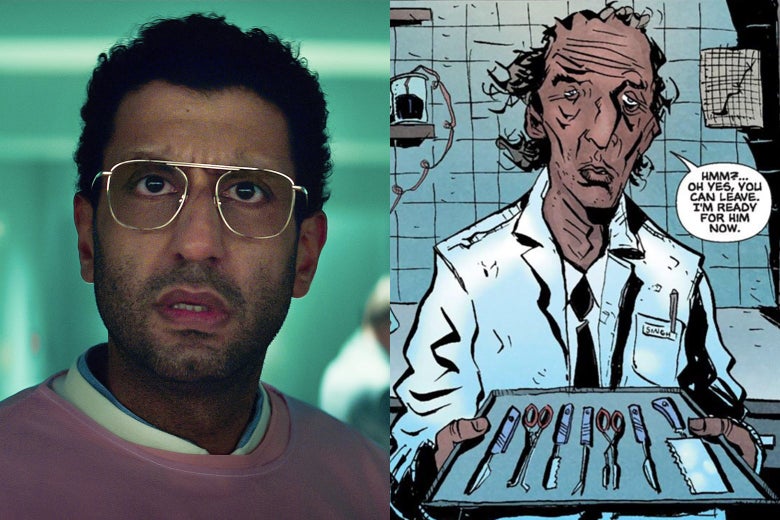

Most of the characters received a similar glow-up in the transition to live-action, and so did the setting. The comic book’s primary visual reference is The Road, and its look is similarly bleak: Sweet Tooth travels from Nebraska to Alaska and back again, crossing a landscape that could generously be described as “blasted.” The TV show narrows its scope to a voyage between Wyoming and Colorado, and its color palette includes the vibrant greens of the overgrown ruins from The Last of Us and the lush meadows of Horizon: Zero Dawn. That’s not to say the TV version of Sweet Tooth is better looking than the comic books—Lemire’s illustrations are striking and weird, while Sweet Tooth is photographed in Netflix’s usual sharp, flat house style—but it’s a lot more inviting. The change in tone can also be heard in the show’s soundscape: The first episode features “Dirty Paws,” the Of Monsters and Men song featured in Ben Stiller’s The Secret Life of Walter Mitty. The song fits the show just fine, but try to imagine how you’d work this expansive, slightly twee needle drop into The Road and you’ll get a pretty good idea of how different Netflix’s Sweet Tooth is from the comic book:
Don’t worry, though: no one in Sweet Tooth gets their groove back by going longboarding in Iceland, at least in the first season.
Gus
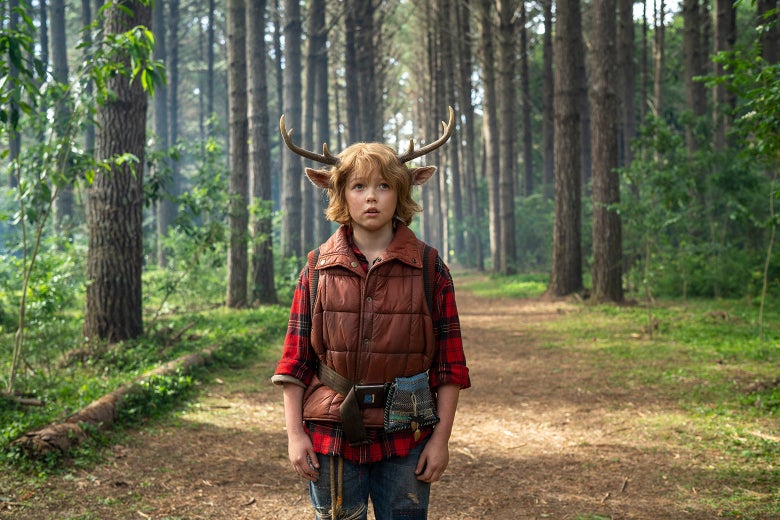

Sweet Tooth’s protagonist, a half-deer hybrid boy named Gus, survives the transition to the screen more or less intact. Actor Christian Convery’s cherubic looks are a big step up from Lemire’s glum, long-faced tween, but the first season of Sweet Tooth takes Gus through the same basic arc he goes through in the first five issues of the comic book: Gus’s father dies, a drifter named Jepperd finds the cabin where they were hiding out, and Gus travels with Jepperd across the remains of America until he is taken captive by a militia group. The details of the trip are pretty different, however, starting with its goal: In the show, Gus leaves the cabin to search for his mother, who he believes is in Colorado. In the comics, Jepperd offers to take Gus to “the preserve,” a place where hybrids can live safely.
Gus’s backstory, to the extent we see it in Sweet Tooth’s first season, seems similar but not identical to the comic book version. Both stories use a Chosen One-type structure, in which Gus is initially presented as a typical hybrid—to the extent a half-deer, half-human can be typical—but he later turns out to have been the very first of his kind, and possibly the cause of the pandemic. In both cases, he is a product of science, but in the TV show, he’s somehow created using microbes found deep in the arctic ice. In the comic book, he’s cloned from the skeleton of a deer/human hybrid found in a frozen cavern alongside several other human/animal hybrid skeletons, and it’s heavily suggested that he may be a reincarnation of the Inuit god Tekkeitsertok. (The show alludes to some of this lore but seems to be saving it for later seasons.) Either way, if you’re looking for a TV show that covers the relatable day-to-day travails of a perfectly ordinary half-deer / half-human kid, neither version of Sweet Tooth is for you.
Pubba
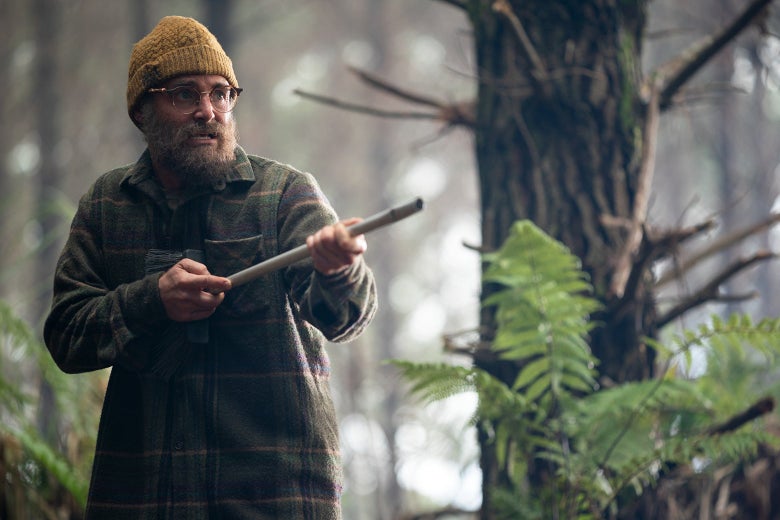

Gus spends his early childhood in the care of his father, who he calls “Pubba.” Played by Will Forte on the TV show, both versions of the character do more or less the same thing: Hide Gus from civilization, teach him to be self-sufficient, then catch the plague and die. The quickest way to see the way the difference between the two characters is to compare sample lines of their dialogue. Here’s something Will Forte’s version of the character tells his son:
I’m the luckiest dad in the world, you know why? Because I got to spend the last nine years with a very, very special boy—you—in a world we got to build together. I couldn’t ask for anything else.
Now here’s something the comic book version of the character tells his son, as part of what are apparently regular sermons he delivers to his son about the end of the world:
And he poisoned the waters and inflicted the air they breathed, and they no longer breathed the Holy Spirit, but instead his pestilent breath of pure death. And all the world’s sinners withered and rotted on the spot, and God looked down and said, “You have sinned, you have lived as evil men, and now you will leave this earth to the good alone.”
As with so many other aspects of Sweet Tooth, the live-action version is considerably more pleasant. Will Forte’s Pubba also tells his son an abbreviated story of the fall of civilization, using an apple being devoured by ants as a teaching aid, but in the comics, Gus’ father is a full-on religious nut, who believes that his son is the first representative of a new race sent by an angry god to replace humanity. Will Forte’s character is an aspiring illustrator who ends up drawing a small library of children’s books for his son; in the comic books, he spends his time writing out new bible spelling out his theories about the hybrids. The two characters share the same backstory and do more or less the same things to advance the plot, but the TV version seems like a much better dad, if you had to choose.
Tommy Jepperd


Tommy Jepperd is a very different guy in the comic book than he is in the TV show. Both versions of Jepperd are gigantic and good at killing people, but in the TV show, Jepperd, played by Nonso Anozie, is a Black former football player whose gruff exterior conceals a heart of gold. In the comic books, he’s white, he used to play hockey, and his heart is as black as his soul, at least at first. On TV, Jepperd agrees to help Gus catch a train to Colorado where he hopes to find his mother, and although he doesn’t think there’s much chance Gus’ mom is alive, he sincerely tries to get him there. In the comic books, Jepperd’s offer of help is a lie: Although he tells Gus he’s taking him to a preserve for hybrids, he instead delivers him to a militia camp where scientists are experimenting on hybrid children in hopes of curing the plague, then barters Gus to them in exchange for his dead wife’s remains. (The militia has his wife’s body because they kidnapped Jepperd and his pregnant wife while collecting hybrid test subjects; his wife dies in childbirth and his kid is seized by the militia.) Over the rest of the comic books, Jepperd redeems himself, but he starts off as a villain.
The TV show’s Jepperd isn’t anywhere near as evil, at least in ways we see on screen. He is a former member of an anti-hybrid militia, and it’s implied that he did terrible things to survive early in the pandemic, but he doesn’t betray Gus. His wife and their hybrid child meet a different fate as well: She delivers her baby much earlier in the pandemic, while there’s still some semblance of civil order, and although baby and mother get disappeared, apparently by government officials, there’s no militia trickery involved. Accordingly, Anonzie’s Jepperd doesn’t have as much of a chip on his shoulder.
The Animal Army
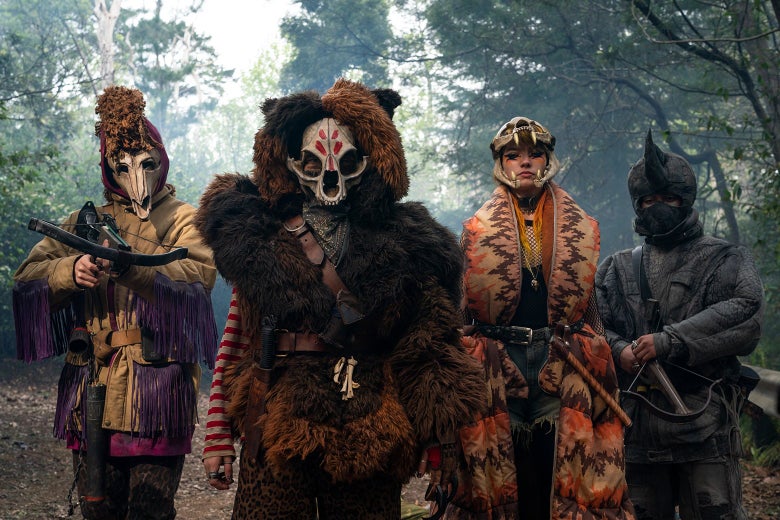

Both versions of Sweet Tooth feature a group of humans who wear animal skulls as masks in imitation of the hybrids, but that’s where the similarities end. In the comic books, the animal army is a group of tribes led by a lunatic named Glebhelm and his five feral half-dog / half-man sons, who began life by devouring their own mother. Glebhelm uses his hybrid sons as trackers and enforcers—he lets them tear one of his own men to shreds for disobeying an order—and although he is extremely interested in other hybrids, that’s mostly because he thinks his sons can absorb their powers by eating them.
The TV show’s animal army is an entirely different thing, except for the costumes. Led by a teenager who calls herself Bear (Stefania LaVie Owen), they are a group of human children who have made a home for themselves in an abandoned amusement park that somehow still has electricity, where they pass their time playing video games and driving bumper cars. Bear and her followers are obsessed with hybrids—Bear had a hybrid little sister who disappeared early in the collapse—but they want to protect them, not feed them to a pack of ravenous dog creatures in hopes of absorbing their powers. Since the comic book and TV show versions of the Animal Army are completely different groups of people, there’s no overlap in their narratives. They just wear the same kind of masks.
Dr. Singh


Dr. Singh, a doctor who ends up experimenting on hybrid children in an attempt to discover a cure for the pandemic, gets a near-complete makeover in Netflix’s Sweet Tooth. In the comic books, readers meet him long after he’s thrown his lot in with an anti-hybrid militia, and besides his medical training, we know very little about his pre-pandemic life. Jim Mickle gives Singh a wife (Aliza Vellni) and an elaborate backstory, which he uses to explore some of the horrifying ways society fractures during the pandemic. Singh works at a hospital that’s overwhelmed by the pandemic; when his wife catches the invariably fatal virus, he finds a way to keep her asymptomatic and hide her diagnosis. (Both viruses are invariably fatal, but the comic book virus causes facial sores, while the tv version causes a tic in the left pinkie finger, a much creepier symptom.) Meanwhile, his suburban neighborhood descends into Shirley-Jackson-style chaos, as a self-appointed neighborhood watch sets about burning the houses of the infected to the ground with the residents still inside. Against that backdrop, Singh seems like a relatable guy trying to keep his wife alive. The comic book version of his character is many things, but “relatable” isn’t one of them. After finding the “bible” Gus’ father wrote, Singh becomes obsessed with his prophecies and comes to believe that Gus is a messiah.
Aimee and the Preserve
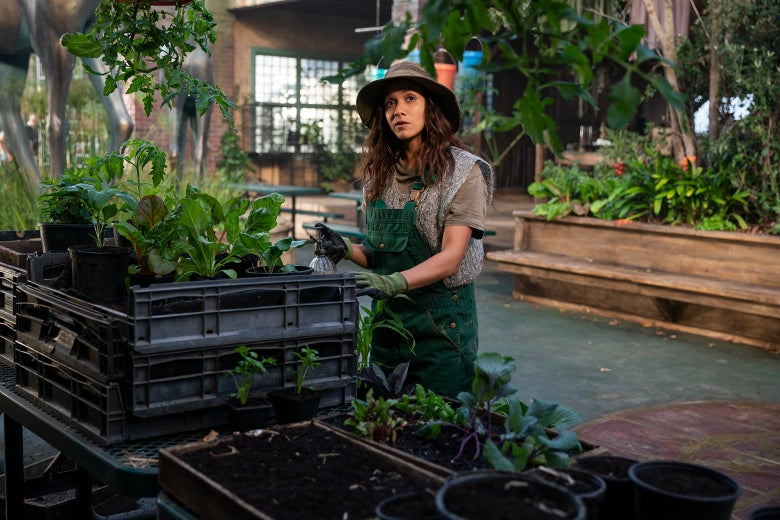

Netflix’s Sweet Tooth has three major plotlines: Gus and Jepperd’s trek across the United States, Dr. Singh’s suburban hell, and the story of a woman named Aimee (Dania Ramirez), who settles after the collapse in a ruined Colorado zoo, where, with the help of a half-pig / half-human hybrid child named Wendy (Naledi Murray), she sets up “the preserve,” a place for hybrid children to live safely. Wendy is in the comic books—Gus meets her in a militia kennel where they’re both being held prisoner—but Aimee was invented for the show. Although the preserve is mentioned in the comic books, it’s unclear if it actually exists or Jepperd is lying about it. It seems likely that Aimee will fill a similar structural role as a character named Lucy in the comic books if Sweet Tooth gets more seasons, teaming up with Jepperd to liberate Gus and the other hybrids from the militia, but she’s original to the TV series.
Steven Abbot
General Abbot, the head of the anti-hybrid militia, seems to have a similar background in both versions of Sweet Tooth, or at least nothing on screen contradicts the comic book version. (For instance, in the comics, Abbot is saddled with a hapless younger brother who keeps screwing things up; that character is present in the show, but his familial relationship to Abbot has not been spelled out.) The comic book version of Sweet Tooth has meaner villains than the TV show, at least in terms of the kind of sociopathic violence that characterizes “adult” comic books, and Abbot is no exception: in the comics, he’s always murdering people. Nevertheless, Steven Abbot is way more memorable as played by Neil Sandilands on the TV show than he is in Jeff Lemire’s drawings. The reason’s pretty simple: In the comic books, Abbot does not evoke a cross between Sonic the Hedgehog villain Doctor Robotnik and Edward Gorey in his raccoon coat days, and in the TV show, he absolutely does:
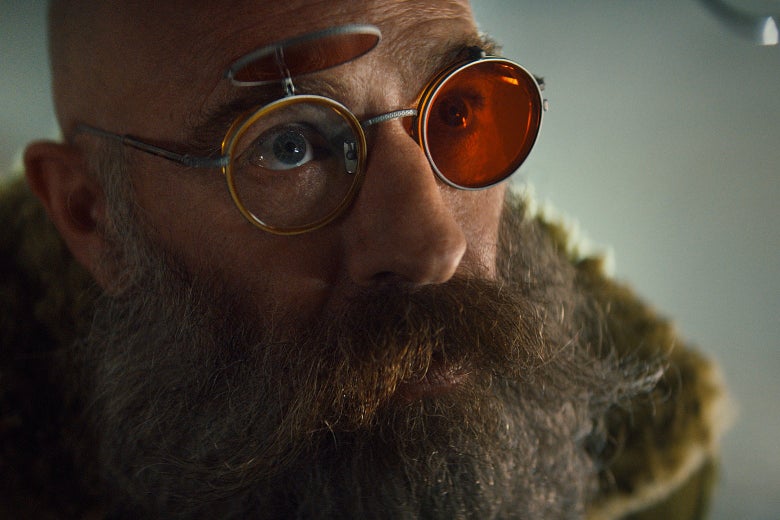

Sometimes, effectively adapting a comic book character for television requires a lot of writing, adding new motivations, fleshing out background details, and even crafting entirely new plotlines before the character comes to life on screen. Sometimes, though, all you really need is a troubling amount of facial hair.
"original" - Google News
June 06, 2021 at 10:53AM
https://ift.tt/3fURZL9
Sweet Tooth: Here's how the new Netflix adaptation differs from Jeff Lemire's original comic books. - Slate
"original" - Google News
https://ift.tt/32ik0C4
https://ift.tt/35ryK4M
Bagikan Berita Ini















0 Response to "Sweet Tooth: Here's how the new Netflix adaptation differs from Jeff Lemire's original comic books. - Slate"
Post a Comment